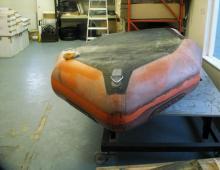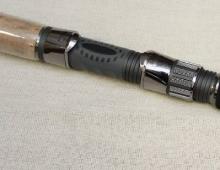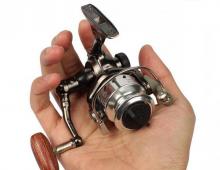Features of summer fishing: mormyshka fishing
Mormyshka fishing in the summer- Mormyshka, which is a sinker, a bait with a hook, was originally invented for catching fish in the winter, but today fishermen are increasingly using such fishing tackle in the summer.
Fishing with jig gear in the summer months is no less interesting than in the winter, but the jig for the summer is usually made larger and heavier than the winter jig. And one of the reasons here is that when fishing on an ice-covered pond, the line with the bait is in close proximity to the angler, in the hole, almost under his feet. And in the summer, the fisherman has to cast the tackle at a distance of up to six meters, and in this case, the information connection along the chain "mormyshka-nod-fishing rod" is less sensitive. Therefore, in order to achieve mutual compliance of all components, it is necessary to choose larger mormyshkas.
rod
In winter, fishermen, using almost weightless rods with light tackle, can play with bait with great frequency and with only one movement of the hand. But when fishing in the summer, playing with a jig located at a considerable distance from the angler is both difficult and difficult.
Although the telescopic rod is made of carbon fiber to lighten the weight, holding and swinging such a “six-meter stick”, made even with modern technology and modern materials, is not an easy task, especially if you practice it for several hours in a row. A six-seven meter rod is the best choice: with a longer length it becomes very difficult to control the tackle, and if the rod is short, then it will be possible to catch only directly near the shore, where it is impossible to catch serious fish.
When fishing with a mormyshka, a skillful game of tackle is the main component of success. But casting distance is also important. There are no special rods for jigging tackle, so every angler must choose for himself a rod of the right length, the most suitable for his fishing conditions.
rigging
The tackle used when fishing with mormyshka, depending on the method of attaching the fishing line, is divided into two types: “deaf” and “running”. At the same time, they say, for example, that this fishing rod has a “dead snap”, and some other one has a “running snap”. By "dead snap" is meant a certain way of attaching the fishing line to the rod, in which it is attached to it "tightly" and wound on a small reel, usually mounted on the third knee.
It is impossible to release a fishing line for a long length with a deaf snap. And since the depreciation properties of the rod are limited, then with a large weight of the fish being caught, the fishing line can experience heavy loads and, accordingly, break off at the most inopportune moment. And if this happens when fishing for a very large fish, it becomes just a shame: after all, every fisherman dreams of large prey. Therefore, when fishing with a blind snap, you must always have a landing net next to you. And it is better if this landing net has a telescopic handle.
The main difference between a fishing rod with a “running” rig is the nature of the operation of this rig, which is “running”, that is, not tightly attached to the rod, but able to lengthen or shorten depending on the situation.
The rods of such fishing rods have throughput rings and a reel. The presence of the reel allows the angler to timely increase or decrease the descent of the fishing line when fishing, which theoretically allows you to catch fish of any size. The fish, having made a jerk, does not break off the tackle, but, overcoming the resistance of the brake of the reel, simply unwinds a small section of fishing line from it. “The fishing line ran,” the fishermen say in this case. That is why such equipment is called "running".
On a fishing rod with a running rig, either an ordinary reel that does not have a deaf brake, or a fly fishing reel can be installed. And the fishing line is chosen, as a rule, with a thickness of 0.1 ... 0.25 millimeters, depending on the circumstances. In summer, using a running rig, you can fish at almost any depth of the reservoir.
nods
Nods on fishing rods with jigging tackle can be lateral or straight. On long rods, lateral nods are more noticeable, which is why they are usually used.

In general, for all fishing rods, their own nods should be selected, which can be lavsan, steel or spring.
Lateral nods
The length of the side nods during summer fishing using mormyshki is chosen depending on the length of the rod. The longer it is, the longer the lateral nod should be. A correctly chosen nod prevents the appearance of sharp fluctuations and allows you to make a smooth and soaring game with a jig. For example, if your rod is 6-7 meters long, then the side nod for it should be about 20 cm long.
When checking the correct choice of the nod, it must be borne in mind that due to the weight of the mormyshka, the nod is usually in a horizontal position or slightly lowered, while without the bait the nod is slightly bent up.
And since the mormyshkas used for fishing can have different weights, then the nods should be paired with them, also different in length. The option with adjusting the size of the nod during the fishing process is inconvenient, since this requires more time than the operation to replace it with another nod. Therefore, when going fishing, it is best to collect many different nods with different lengths.
It is useful to wear multi-colored signaling devices made of some light, brightly colored materials, such as foam or pieces of colored tubes, on the tips of the nods.
Mormyshki
Summer mormyshkas are usually larger than winter ones. At the same time, the heaviest of them are used when fishing in reservoirs with a large current or depth. And also when they are going to catch obviously very large fish. The main thing when fishing with a mormyshka is a skillful game of such tackle, which depends to a large extent on the experience of the angler. The vibrations of the moving mormyshka catch the fish. With the right technique of playing tackle, you can count on the bite of exactly the fish that they expect to catch.
It is more difficult to fish with a mormyshka in summer than in winter, as it is more difficult to ensure a good game with it. With the help of a slow almost motionless game, you can interest the bait of bream, ide, roach, and perch can be attracted by the frequency fluctuations of the mormyshka.

You can also use this equipment: tie a hook on a leash, and put a white cambric on it, and tie not one leash, but two or three, and each with a hook at the end.
You can catch mormyshka in the summer both from the shore and from a boat. But in the latter case, the use of jig tackle becomes very effective.
Fishing from a boat and its features
When fishing from a boat, you can use the same short fishing rod that was used in winter, while the line must be wound on a reel and pulled through a nod, and a mormyshka must be tied at its end. A reel can be used instead of a reel. Hooks need to be chosen strong, and mormyshkas - resembling live food in appearance. You need to fish either near the bottom, or a little higher.
In spring, it bites well in shallow water, and with the advent of autumn, the fish begins to look for deeper places, so you can only find it at this time at depth: in pits and whirlpools.
Fishing from the shore
When fishing from the shore, anglers often have to stand motionless in the water for a long time, wearing, of course, wader boots or special overalls, as sometimes they have to go into the water up to their chest.
How to fish in still water?
When fishing in lakes and ponds, you need to throw the mormyshka as far as possible, and after it reaches the bottom, pull it up in jerks or drag it along the shore.
The jig should be raised slowly, making stops, after which it should be lowered slightly. During the game, you can tap your finger on the rod at the place where the reel is attached to create oscillations of the tackle at a certain frequency.
If the bottom of the reservoir is covered with vegetation, then the jig should be thrown into those places where there are no plants, and which are therefore called “windows”. The mormyshka must be thrown to the far point of the window, otherwise hooks cannot be avoided during the game. If the nozzle is a live bait, then you can catch a pike on it, but most often a perch is caught in the windows. In the process of fishing, you need to move all the time: you should not stand in one place for a long time, if there is no bite, after making several unsuccessful casts, you need to go fishing in another window.
Fishing in the current
If you are fishing in a river with a current, then the mormyshka should be kept near the bottom. First you need to cast upstream, and as soon as the nod shows that the mormyshka has reached the ground, you need to start doing the wiring. At the same time, while making oscillations, it is necessary to achieve a smooth game of the bait, not raising the mormyshka too high and not lowering it to the bottom, and at the same time it is necessary to maintain the vertical position of the fishing line relative to the surface of the water.
Headless seaweed

The technique of fishing with a baitless mormyshka is not available to everyone, but only to experienced fishermen. When fishing with a jig without a jig, you need to have a well-chosen tackle and be able to create the desired, as a rule, high frequency of oscillation. It is also important to be able to choose the “correct” mormyshka: for example, fish bite well on lead mormyshkas with a light hook. In this case, you can experiment and use PVC tubes of different colors.
Nozzles and bite
If you have equipped your rod with a side nod, then it is best to use animal baits: for example, bloodworms (which are good for bream, perch and ruff) or maggots (for catching roach), or worms (for larger fish).
A bite can usually be felt with the hand holding the rod. And if you feel a hook, then cut sharply so that the fish sits securely on the hook.



